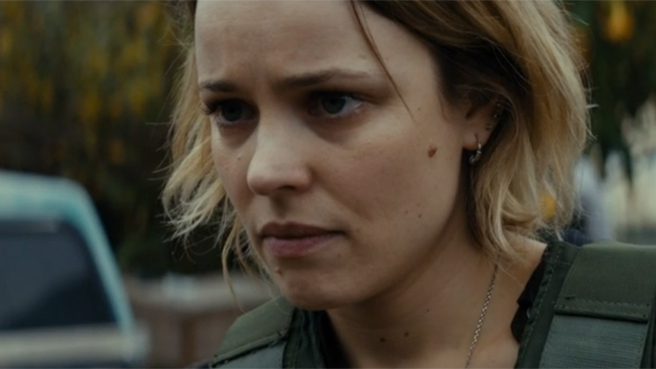About halfway through “The Western Book of the Dead,” episode one of True Detective’s second season, sheriff’s detective Ani Bezzerides (Rachel McAdams) and her partner visit the Panticapaeum Institute, the campus of a vaguely eastern religious organization that overlooks the Pacific Ocean. The pair are in search of information about a missing woman, but Bezzerides wanders into a grotto, where a speaker who we’ll soon learn is the head of the Institute and Ani’s father is sitting crosslegged. “Today’s exercise is to recognize the world is meaningless,” he says to a group. “And to understand that God did not create a meaningless world. Hold both thoughts as irrefutable and equal.”
This world—a world of contention, of squandered opportunities and compromised improvisation—is the world in which True Detective’s suffocatingly dramatic first season unfolded. And if “The Western Book of the Dead” is any indication, it’s what we’re in for with season two as well. We’re introduced to Detective Ray Velcoro (Colin Farrell) as he gives his son Chad advice on how to handle bullies at school. “I love you, buddy,” Velcoro says, “Be proud.” Later in the episode, after we’ve learned that Chad was born nine months after his mother was raped, we see Velcoro collapse the bully’s father’s face with a set of brass knuckles.
The beating comes on the same day that Velcoro has savagely assaulted a reporter who promises to shed light on corruption in the small town of Vinci, California. Velcoro is working at the behest of Frank Semyon (Vince Vaughn), the crime boss who (we’re led to believe) murdered the man who raped Velcoro’s wife. Semyon is heavily involved in the development of the land surrounding the high-speed rail system being built on the California coast in an attempt to move away from the criminal world. (“It’s a chance for your grandkids to be from one of those rich old California families,” he tells Osip Agranov, an eastern European investor who seems to be no straighter than Semyon.)
A bit farther south on the PCH, highway patrolman Paul Woodrugh (Taylor Kitsch) pulls over an actress with an ankle monitor and a suspended license who tries to woo her way out of jail time. Woodrugh’s thousand-yard stare is unaffected; moments later, we’re told that the actress is claiming that he propositioned her, and just like that we have a tabloid sensation that the episode nods toward but smartly avoids.
All four of True Detective’s principal characters are either complicit in the draining of meaning and goodness from the world or subject to the effects of that drainage. Oftentimes both. From the episode’s opening moments, an unspoken sense of evil—born not from the vaguely occult world of True Detective’s first season but from sheer monotony—hovers. It’s there in those long, visually stunning and dramatically terrifying shots of the California freeway system, all those cloverleafs and entrance and exits, all of those individual lives moving slowly from one place to the next. It was always tempting to imagine that show creator Nic Pizzolatto didn’t have to work very hard to make season one’s exotic southern Louisiana setting seem creepy; seeing those same aesthetic techniques applied so expertly to something so mundane as the 101 or the industrial landscape of Vinci is almost nauseating.
But that’s where the similarities between True Detecitive’s two seasons end. There are no composed corpses in “The Western Book of the Dead,” and Velcoro’s brief tour of the sex toys and violently erotic art in the home of Ben Caspere—Semyon’s missing business partner whose murder brings Woodrugh, Bezzerides, and Velcoro together—is the closest we come to the occult. Bezzerides and her partner don’t argue about the nature of humanity as they drive from location to location; the above description of a grayed-out cosmos is the closest we come to any discussion of the nature of the world.
So what’s left? Largely: procedure. While season one’s first scene drove us straight into the madness, “The Western Book of the Dead” is much moodier. The plot should look familiar to anyone who’s spent any time watching traditional badge-and-gun shows, but the feeling is entirely different. The episode’s granular visual details—Woodrugh’s cheeks flapping in the wind as he pushes his motorcycle to suicidal speeds during a night ride, Semyon’s blank stare as he’s introduced to Agranov’s lawyer—lend the episode the same sense of entropic sadness that characterized most of season one. We’re one episode in and it already seems impossible that solving of Caspere’s murder will feel satisfactory in any way whatsoever. It’s a meaningless world, after all. But because of the way it was created, we’ll keep searching for whatever we can get.









